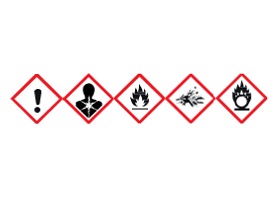
GHS
Globally Harmonised System of Classification and Labelling of Chemicals (GHS)

If you order, handle or store chemicals in the workplace you need to comply with “GHS”.
The Globally Harmonised System of Classification and Labelling of Chemicals (GHS), was introduced by the UN to internationally standardise chemical classification, labelling and safety data sheets (SDS) in the workplace. The GHS uses a common set of pictograms, signal words and hazard warnings to universalise classifications.
All chemical purchases must be GHS compliant (both labels and SDS). Existing stocks of hazardous chemicals (with NOHSC (from 2004) and ADG Code labels) do not need to be re-labelled, but if they are not required they must be disposed of. Chemicals purchased before 2004 must be disposed of through the chemical waste collection unless there is a specific need for them to be retained (e.g. no longer available, specific batch required for research etc.) in which case they must be re-labelled to GHS compliance. All preparations of decanted chemicals and prepared mixtures and solutions must be labelled to GHS requirements. All SDSs must be GHS and if you identify an SDS in the chemwatch manifest which is not GHS, please request a GHS version from the supplier you purchased the chemical from and load it into the chemwatch database.
It is recommended to only purchase from countries who have implemented GHS themselves and it is advisable to purchase from an Australian supplier. Researchers should be aware that chemicals ordered directly from an overseas supplier/manufacturer makes them the importer and therefore the person responsible for ensuring the labelling and SDS is GHS compliant. It is recommended for any direct overseas order that the person making the purchase request the supplier ensure the material and SDS is GHS compliant and check this is the case on receipt.
Agricultural and Veterinary (AgVet) medicines listed in Schedule 8 of the Standard for the Uniform Scheduling of Medicines and Poisons (SUSMP) will not require GHS labelling. AgVet medicines listed in Schedule 4 of the SUSMP that are in a form and packaging consistent with direct administration to animals will not require GHS labelling.
Transition to GHS 7
On 1 January 2021, Australia began a two year transition from GHS Revision 3 to GHS Revision 7. Safe Work Australia has published a webinar to help businesses transition to GHS 7. Topics covered include:
- what the GHS is, why it is changing and what it will mean for businesses
- transition arrangements
- what is changing, including changes to classification and labelling requirements.
Watch the Transition to GHS 7 webinar and for more information go to the GHS 7 transition web page.
Further resources
Chemwatch training module: Click on this link to complete the Chemwatch GHS Training Module.
Training modules guidance on producing Chemwatch labels and creating SDS for mixtures:
The University of Newcastle acknowledges the traditional custodians of the lands within our footprint areas: Awabakal, Darkinjung, Biripai, Worimi, Wonnarua, and Eora Nations. We also pay respect to the wisdom of our Elders past and present.